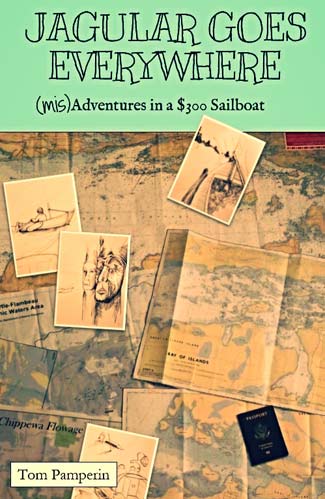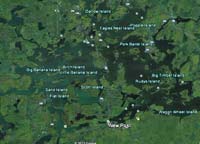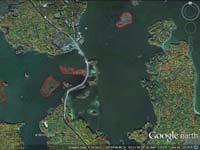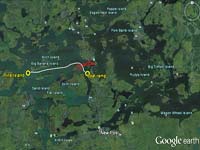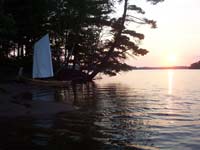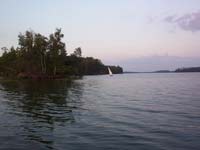
 Custom Search
|
| boat plans |
| canoe/kayak |
| electrical |
| epoxy/supplies |
| fasteners |
| gear |
| gift certificates |
| hardware |
| hatches/deckplates |
| media |
| paint/varnish |
| rope/line |
| rowing/sculling |
| sailmaking |
| sails |
| tools |
| join |
| home |
| indexes |
| classifieds |
| calendar |
| archives |
| about |
| links |
| Join Duckworks Get free newsletter CLICK HERE |
|
|
| JAGULAR GOES EVERYWHERE |
by Tom Pamperin - Chippewa Falls, Wisconsin - USA |
(mis)Adventures in a $300 Sailboat It’s official: I’ve finished my Jagular book! (Details HERE).
Many of you have been with us from the beginning, when Chuck Leinweber published Jagular Gets Rescued back in 2009. I hope you’ve enjoyed our adventures so far. You’ll find one more below. And thanks, Chuck, for getting me started. I owe you one. Again. If you’re joining Jagular and me for the first time, we’re glad to have you along. If you like today’s story, you can find more here: I hope these stories remind us all that when it comes to adventure, there’s no need for deep pockets or deep-keeled ocean cruisers. Adventure’s where you find it - and a small boat can find it much closer to home than a big one can. Finally, if you enjoy my writing, please support my book on Kickstarter.com before the project ends on March 4th - every little bit helps, and the sooner the better: It’s expensive to publish a book without a traditional publisher, but if you enjoy my writing, you can help make it happen. You’ll earn cool thank-you gifts along the way, too - T-shirts, bumper stickers (err, I mean transom stickers, of course), ebooks, signed copies of the book, and more! (See the Kickstarter link above for details.) Most importantly, please share the Kickstarter link with everyone you know - sailors, boat builders, friends, family, Facebook, Twitter, Google+, and whatever else you use. But don’t wait too long - the Kickstarter page will close on March 4th. After that, it’ll be too late to be part of it all. Many thanks, as always. Enjoy this exclusive Duckworks-only preview of “Jagular in the North Woods.” And remember: You don’t have to be prepared as long as you’re willing to suffer the consequences. Tom Pamperin Part One - Part TwoJagular in the North Woods - Part Oneby Tom Pamperin Toward the end of summer, having little or no money in my purse, and nothing particular to interest me on shore, I thought I would sail about a little and see the watery part of the world. “Nonsense,” I tell him. “I’m done with all that for now. It’s time to go off into the world and see what there is to be seen, do what there is to be done. It is a way I have of driving off the spleen, and regulating the circulation. With a rhetorical flourish Cato throws himself upon his sword; I quietly take to the ship.” “Quietly?” Jagular asks. I ignore him. “Now, when I say that I am in the habit of going to sea whenever I begin to grow hazy about the eyes, and begin to be over conscious of my lungs, I do not mean to have it inferred that I ever go to sea as a passenger. For to go as a passenger you must needs have a purse, and a purse is but a rag unless you have something in it. “Besides, passengers get sea-sick—grow quarrelsome—don’t sleep of nights—do not enjoy themselves much, as a general thing;—No, I never go as a passenger; nor, though I am something of a salt, do I ever go to sea as a Commodore, or a Captain, or a Cook.” “Mainly because you’d actually have to cook something instead of just eating cold ravioli from a can,” the boat says. “More nonsense,” I say. “I abandon the glory and distinction of such offices to those who like them. For my part, I abominate all honorable respectable toils, trials, and tribulations of every kind whatsoever. It is quite as much as I can do to take care of myself, without taking care of ships, barques, brigs, schooners, and what not.” “That’s true enough,” Jagular says. “Now listen,” I tell the boat, “and stop your foolish badgering. For there is a place not far from here,” I say, “a watery web of lakes and islands, a hidden wilderness at the very headwaters of the Chippewa River. It is a place unlike any other, replete with virgin timber and clear fast-running streams, a place where we shall see bears and wolves, and mooses, and minks, and otters; we shall discover muskellunges and snapping turtles of the largest size. Deers and coyotes and perhaps even ocelots roam the forests; red-eyed loons make the lakes echo with their eerie calls; eagles swoop low over the rushing waters; and wood ducks gather in flocks so large that they blacken the very skies with their passing.”
“Why are you telling me all this again?” Jagular says. “It’s all you’ve been talking about for weeks now. And besides, I doubt we’ll be seeing any ocelots.” “Who knows what we shall discover?” I say. “For we shall be alone in the north woods—” “Alone?” the boat says. “I thought your brother was meeting us there.” “He is. But we’ll be alone anyway. His boat might be faster than we are in light airs, but if we get any real wind we’ll leave him behind.” I stop for a moment to gather my thoughts. “So. We shall be alone in the north woods, free to find whatever is waiting to be found; we shall roam the waters at will and camp where we please, moving from one island to the next, riding the wind where we can, and rowing where we must.” “Over-rated,” I say. “But we do have oars this time. I can just bungee them to the leeboard cleats and row that way for now.” “How about a real tiller?” It’s a good question. Jagular’s tiller is truly pathetic, a hastily chopped off two-by-two with feeble half-inch tongues screwed on to overlap the rudder cheeks and hold the quarter-inch bolt that secures the tiller to the rudder head. The whole thing is outlandishly crude and over-sized, but constructed so poorly it’ll probably fall apart the first time we try to tack. Even I’m ashamed of it, and that takes some doing. No time to fix it, though, so I just aim an angry stare at the boat. “What about some reef points, then?” Jagular asks. “Eighty-five square feet is an awful lot of sail area.” “Humbug!” I say. “Reefing is for sissies. Sailing is supposed to be exciting, not just sitting around being wet and bored. Fear is an essential ingredient of any adventure, the crucible in which the raw clay is fired, the molten steel tempered.” Jagular sighs. “The paint is still peeling off the bottom in huge sheets, you know.” * * * Several hours later we arrive at the headwaters, a quiet collection of lakes and streams surrounded by a second-growth forest of pine, birch, oak, and maple. It’s late afternoon, and the unpaved parking lot is empty. The real north woods—endless tracts of white pines two hundred feet tall, trees so big that two men together couldn’t reach around them—that forest is gone forever, I know, the trees clear-cut and stacked up and hauled out and rafted down to riverside sawmills in Eau Claire and Chippewa Falls and a hundred other lumber towns that have faded into obscurity. But at least there’s something. Better than the bleak fields of amputated stumps we would have found a hundred years ago. Before long, my brother’s Jeep rattles into the parking lot. He unloads his boat, and we take a brief look at the map together, carefully avoiding any agreements or decisions—our usual approach to planning. Then I launch Jagular and set off, steering a broad reach north past Scott Island and Turkey Vulture Island and a half dozen other islands scattered across the map, too small for names. A quarter mile behind us my brother launches his boat and follows in our wake. * * * Just past Turkey Vulture Island the wind dies away to nothing, leaving us floating around listlessly. I start to fiddle with the sheet and leeboards, trying to find a combination that will give us maximum drive and minimum drag. Nothing seems to make any difference. “Why worry about it? That has to be Turkey Vulture Island,” I tell him. “We sailed north from the boat ramp and then turned west. It’s the only thing that makes sense.” “Turkey Vulture Island’s not shaped like that on the map,” he insists. “And I don’t see those two little islands at all.” “Look, Big Banana Island is right there,” I point out. “And that’s Little Banana, with the channel between them. We can’t be anywhere else.” But order must be restored, the errant stars set back in their courses, and my brother knows me well enough to realize that I won’t be the one to do it. He keeps staring at the map as if trying to force it to match our surroundings by sheer force of will. I’m getting tired just watching him. It’s a lot easier to be me than it would be to be anyone else, I decide. “It can’t be that easy,” Jagular says. “So far you’re the only one who has managed it.” I choose to take it as a compliment. * * * According to the now-suspect map, there’s a campsite about a mile ahead on Pine Island, just where the channel between Big Banana Island and Little Banana Island opens up again. When my brother finally gives up on figuring things out, we decide to camp there for the night. We drift around some more, working our way into the narrow passage between the two islands. Sometimes we’re closer to one. Sometimes we’re closer to the other. All around us the water stays flat and smooth. The air stays still and silent. The sun drops slowly toward the horizon. Nothing else seems to be moving. There’s a bald eagle circling overhead but even he seems motionless, painted onto the evening sky. I pull up the leeboards entirely to reduce friction with the water, try poling the sail out with an oar to catch what little wind there might be. We creep forward. My brother drops his sail and starts rowing. He draws even, then passes us. I pull out our oars. “I bet you’re wishing you had some oarlocks,” Jagular says. “Nonsense,” I say. “Watch this.” I pull a mass of bungee cords from the stowage compartment in the bow and start to lash one oar to the starboard leeboard cleat. But it’s not going to work—the leeboard is in the way. “I’m watching,” Jagular says. I’ll have to untie the leeboard and stow it in the cockpit if I want to row. Both leeboards, I realize. Lead-weighted slabs the size of coffee tables. The hell with that, I decide. We can ghost in, even if it takes a little longer. Meanwhile my brother’s boat is moving steadily down the channel toward Pine Island. He pulls gently at the oars. His boat glides forward. He looks around at the sky. The soaring eagle. The lake. The trees. He pulls at the oars again, putting so little effort into the stroke that I can barely see him move. He looks around again: lake, sky, trees, eagle. Takes another half stroke with the oars. The gap between us is growing steadily. “Still watching,” Jagular says. Grumbling and muttering, I pull the leeboards aboard and try to find someplace to put them where they’re not entirely in the way. I lash the oars to the leeboard cleats, securing each one with an ugly overlapping tangle of bungee cords, trying to create enough tension to hold the oars in place. Then I raise the kick-up rudder and lash the tiller amidships. All the while the sail swings back and forth above the cockpit on its eighteen-foot spar. Nowhere to go with that. It’ll have to stay hoisted. I lash the sail into an untidy bundle with some bits of line. Even with the sail furled and mostly out of the way, the weight of the yard makes the boat rock back and forth alarmingly each time I shift my weight. Up ahead my brother is approaching the sandy spit at the tip of Pine Island. Finally I’m ready to row. There’s no seat aboard Jagular, so I stack a couple of float cushions under me so I can reach the oars comfortably. With bungee cords for oarlocks I can’t put much force into my stroke or the oars will pop right off the leeboard cleats, but it’s working, kind of. We’re moving. Up ahead my brother’s boat glides up onto the sand spit and he steps lightly ashore.
Aboard Jagular, the exposed bolt heads on the leeboard cleats are grinding away at the oars with every stroke. The float cushions I’m sitting on shift and slide underneath me as I pull and I have to stop every few strokes to adjust them. The sail unfurls itself and spills into the cockpit until finally I stop rowing to retie it. Rowing again, but the bungees are stretching. After a while the starboard oar pops off the cleat entirely. I re-tie it. Two strokes later the port oar pops off. I re-tie it. The cushions suddenly slide in opposite directions and spill me onto the cockpit floor. “Oarlocks,” the boat muses quietly. “Shut up,” I say. Meanwhile my brother has returned from his exploration of Pine Island and starts to unload camping gear from his boat. I adjust the cushions and take another stroke. Both oars pop off their bungees simultaneously, and Jagular drifts to a halt in the shallows just off Big Banana Island. “The hell with this,” I tell the boat. “We’re sailing in from here.” “Want to bet?” Jagular says, but I pretend not to hear. I unwrap the bungees and the oars, tie the leeboards back onto the boat, and unfurl the sail. I untie the tiller and lower the rudder, adjust the cushions, then sit back down ready to sail. The tiller is lifeless in my hand. The sail waves back and forth without ambition. The water is still and calm and flat as polished glass. If I try hard enough, though, I can almost imagine some faint motion toward Pine Island where my brother is sitting alone on the beach now, leaning comfortably against a huge log, his boat and gear safely stowed for the night.
Off to the west behind the islands, the sun drops below the treetops. The sky grows slowly darker. Stars are appearing in the twilight, first one, then another. And another. Then whole constellations. The Big Dipper. Cassiopeia. And, faint at first but growing steadily brighter, the Little Dipper. The North Star. “At least were not going to get lost,” Jagular says. Ahead on Pine Island my brother calmly gathers firewood, lights a fire. The cheery flicker of the flames is mirrored in the dark water, a shining path lighting our way to camp. Somewhere off across the water a loon calls. The sail hangs overhead without doing anything at all. We keep not moving slowly toward the shore. To Be Continued... |
To comment on Duckworks articles, please visit one of the following:
|
 |


